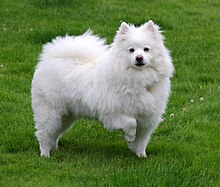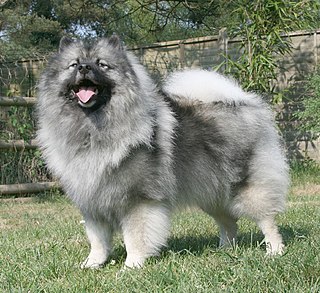
The Keeshond is a medium-sized dog with a plush, two-layer coat of silver and black fur with a ruff and a curled tail. The Keeshond is descended from ancient Arctic dogs. Their closest relatives are the German spitzes such as the Großspitz, Mittelspitz, Kleinspitz, Zwergspitz (Dwarf-Spitz) or Pomeranian.

The Black and Tan Coonhound is a breed of hunting dog. Developed in the United States from crosses between the Bloodhound and the Black and Tan Virginia Foxhound, this scent hound runs its game entirely by scent and is used primarily for raccoon hunting.

The Alaskan Malamute is a large breed of dog that was originally bred for its strength and endurance, to haul heavy freight as a sled dog, and as a hound. It is similar to other arctic breeds such as the husky, the spitz, the Greenland Dog, Canadian Eskimo Dog, the Siberian Husky, and the Samoyed.

The Chinook is a breed of sled dog, developed in the state of New Hampshire during the early 20th century. The Chinook is New Hampshire's official state dog.

The Miniature Schnauzer is a breed of small dog of the Schnauzer type that originated in Germany in the mid-to-late 19th century. Miniature Schnauzers may have been developed from the smallest specimens of the Standard Schnauzer, or crosses between the standard and one or more smaller breeds such as the Affenpinscher, Miniature Pinscher, and Poodles, as farmers bred a small dog that was an efficient ratting dog. They are described as "spunky" but aloof dogs, with good guarding tendencies without some guard dogs' predisposition to bite. Miniature Schnauzers are recognized in four colors internationally: solid black, black and silver, salt and pepper, and white.

The Goldendoodle is a designer dog created by crossbreeding a Golden Retriever and a Poodle. First widely bred in the 1990s, they are bred in three different sizes—each corresponding to the size of Poodle used as a parent.

The Poodle, called the Pudel in German and the Caniche in French, is a breed of water dog. The breed is divided into four varieties based on size, the Standard Poodle, Medium Poodle, Miniature Poodle and Toy Poodle, although the Medium Poodle is not universally recognised. They have a distinctive thick, curly coat that comes in many colors and patterns, with only solid colors recognized by breed registries. Poodles are active and intelligent, and are particularly able to learn from humans. Poodles tend to live 10–18 years, with smaller varieties tending to live longer than larger ones.
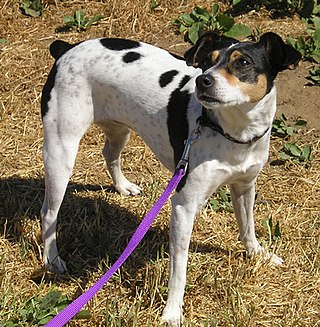
The Rat Terrier is an American dog breed with a background as a farm dog and hunting companion. They share much ancestry with the small hunting dogs known as feists. Common throughout family farms in the 1920s and 1930s, they are now recognized by the United (UKC) and American Kennel Clubs (AKC) and are considered a rare breed. Rat Terriers are an intelligent and active breed that can be kept both for pest control and as a family pet.

The Toy Fox Terrier is a small terrier breed of dog, directly descended from the larger Smooth Fox Terrier but since 1936, it has been registered in the USA with the UKC as a separate breed.
Rat terrier Toy dog traditionally refers to a very small dog or a grouping of small and very small breeds of dog. A toy dog may be of any of various dog types. Types of dogs referred to as toy dogs may include spaniels, pinschers and terriers that have been bred down in size. Not all toy dogs are lap dogs.
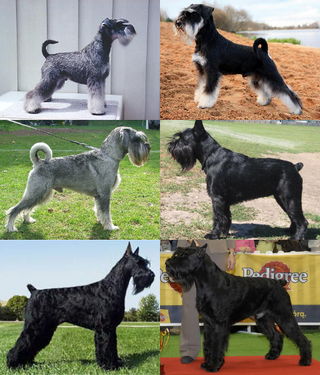
A Schnauzer is a dog breed type that originated in Germany from the 14th to 16th centuries. The term comes from the German word for "snout" and means colloquially "moustache", or "whiskered snout", because of the dog's distinctively bearded snout. Initially it was called Wire-Haired Pinscher, while Schnauzer was adopted in 1879.

The Miniature Pinscher, also known as the Zwergpinscher and Mini Pin, is a small breed of dog of the pinscher type originating in Germany. While the breed's visual similarities to the Toy Manchester Terrier, which somewhat resembles the Pinscher breeds, remain a matter of controversy, genetic research has shown that the two breeds have shared, unique ancestry. The ancestors of the Toy Manchester and Miniature Pinscher may have become geographically separated many centuries ago and retained similarities simply through breeding selection for the same traits; nevertheless, the 2017 research also showed that the two breeds remain more closely related to each other than to other breeds. The breed's ancestors may also include the German Pinscher, Italian greyhounds and dachshunds. The Miniature Pinscher's known origins are in Germany, where it was often referred to as the Zwerg Pinscher in historical documents. German Kennel Club documents also refer to the Miniature Pinscher as the "reh" Pinscher, but this term is only used for a dog of stag-red color, "reh" referring to a small red deer formerly found in German forests. The Miniature Pinscher originated several centuries ago as an efficient barnyard ratter.
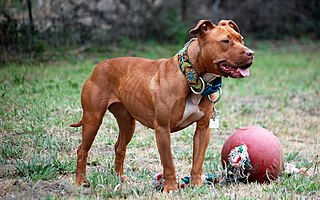
The American Pit Bull Terrier (APBT) is a dog breed recognized by the United Kennel Club (UKC) and the American Dog Breeders Association (ADBA), but not the American Kennel Club (AKC). It is a medium-sized, short-haired dog, of a solid build, whose early ancestors came from England. When compared with the English Staffordshire Bull Terrier, the American Pit Bull Terrier is larger by margins of 6–8 inches (15–20 cm) in height and 25–35 pounds (11–16 kg) in weight. The American Pit Bull Terrier varies in size: males are normally about 18–21 inches (45–53 cm) in height and around 35–60 pounds (15–27 kg) in weight, while females are normally around 17–20 inches (43–50 cm) in height and 30–50 pounds (13–22 kg) in weight.
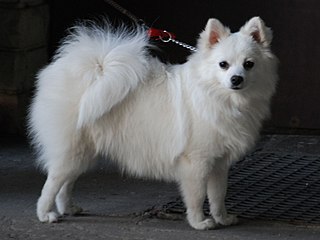
The Volpino Italiano or Volpino is an Italian breed of dog of Spitz type. It is closely related to the Pomeranian and to the German Spitz.
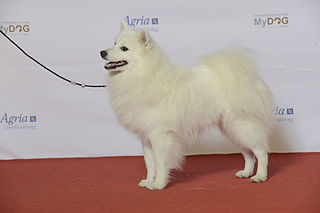
The Japanese Spitz is a small to medium breed of dog of the Spitz type. There are varying standards around the world as to the ideal size of the breed, but they are always larger than their smaller cousins, the Pomeranian. They were developed in Japan in the 1920s and 1930s by breeding a number of other Spitz type dog breeds together. They are recognized by the vast majority of the major kennel clubs, except the American Kennel Club due to it being of similar appearance to the white Pomeranian, American Eskimo Dog and Samoyed. While they are a relatively new breed, they are becoming widely popular due to their favorable temperament and other features.

The Alaskan Klee Kai is a spitz-type breed of dog, developed in the late 20th century as a companion-sized dog resembling the larger Alaskan Malamute and Siberian Husky. It is an energetic, intelligent dog with an appearance that reflects its northern heritage. Bred in three sizes, its weight range is from 5 to 22 pounds as an adult, depending on whether its a standard, toy, or miniature.

The Boykin Spaniel is a medium-sized breed of dog, a Spaniel bred for hunting wild turkeys and ducks in the Wateree River Swamp of South Carolina, in the United States. It is the state dog of South Carolina, where it was discovered and further developed by hunters in the early through mid 1900s. September 1 is Boykin Spaniel Day in South Carolina, originally established in 1984.

The Drever is a breed of dog, a short-legged scenthound from Sweden used for hunting deer and other game. The Drever is descended from the Westphalian Dachsbracke, a type of German hound called Bracke. The breed name Drever was chosen through a contest in 1947.
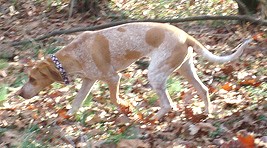
The American English Coonhound, also referred to as the English Coonhound or the Redtick Coonhound, is a breed of coonhound that originated in and is typically bred in the Southern United States. It is descended from hunting hounds, especially foxhounds, brought to America by settlers during the 17th and 18th centuries. The breed's first recognition came from the United Kennel Club in 1905 as the English Fox and Coonhound. Further recognition has been granted in recent years by the American Kennel Club, first in the Foundation Stock Service and in 2011 as a fully recognized member of the hound group.
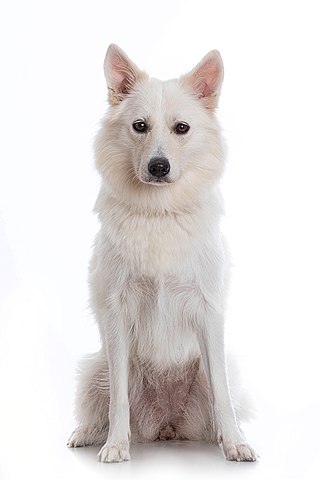
The Danish Spitz is a dog breed, originating from Denmark. The breed is known for making a good family pet, particularly as they are patient with children. Throughout time they've been known under various names, including Samoyed Spitz, Wolf Spitz, Greenland Spitz and White Spitz, which made it difficult to keep track of the breed and the breeding. Today the breed is known as the Danish Spitz.
